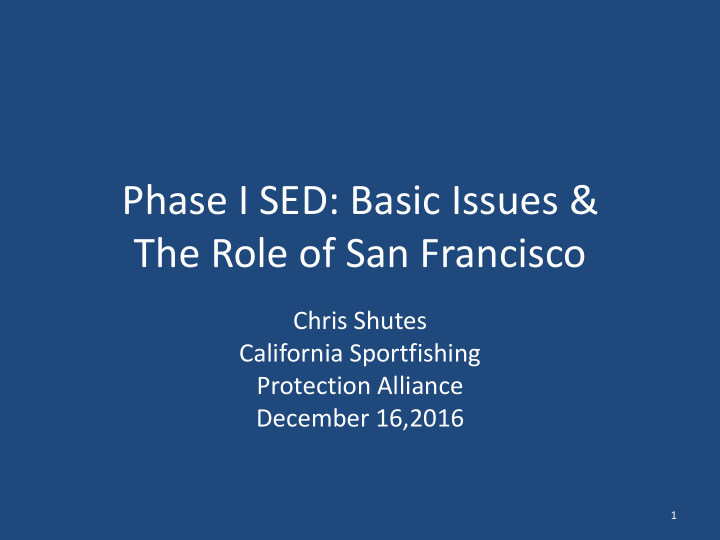



Phase I SED: Basic Issues & The Role of San Francisco Chris Shutes California Sportfishing Protection Alliance December 16,2016 1
Presentation summary • Change the paradigm: unsustainable levels of water deliveries from the San Joaquin tributaries • San Francisco and Bay Area water agencies must do their fair share • Wrap-up 2
California has an unsustainable agricultural business model • Boom and bust cycle built on overallocation of water: too much delivery in good years creates crisis after 2-3 dry years • System is only semi-functional by diverting water needed for public trust resources and/or over-pumping groundwater • Restoration of protective flows for rivers and SGMA are not the cause of overallocation: they just daylight it 3
Unsustainable level of deliveries Watershed Median /average Average annual Average Annual annual runoff agricultural M&I deliveries (TAF) deliveries (TAF) Merced 721/884 445 (Merced ID) Tuolumne 1514/1851 757 (TID+MID) 30 (MID) ~225 (SFPUC, BAWSCA) Stanislaus 922/1100 445 (SSJID+OID) 30 (SEWD); may vary Up to 49 (CSJWCD); may vary Source: SED. Merced: p. 2-16 Tuolumne: pp. 2-18 to 2-20. Stanislaus : pp. 2-27 to 2-33 Note: does not include riparian diversions 4
No basis for 40% Feb-June unimpaired Block or Budget • The science says 40% is not enough • Block loses variability: go back to 7-day running average • Flow shifting steals winter/spring water to solve summer/fall problems: budget enough to do the job • If spring flow increases water temperature in summer, don’t say it “could” be fixed. Own it. 5
Need rules in SED Analyze real alternatives for: • Adjusting flows to water year types • Reduced irrigation deliveries • Carryover storage (numbers, please) • Default triage in CD years and drought sequences based on specific functions • Export operations • San Francisco contribution to flow No punting to adaptive management 6
Two major agreements must change • 1988 Stipulation Agreement on Stanislaus between BOR and OID/SSJID 600 TAF/year to 2 districts too much draw • 1966 Fourth Agreement between TID/MID and SFPUC makes SFPUC ~50% responsible for flow increases on Tuolumne Formula falls apart with needed magnitude of flow increase: SF gives up an amount that would be greater than its annual demand • Board must reduce draw on both rivers, and most of that draw is from senior diverters 7
Conservation disparities • San Francisco per capita water use among lowest in state • BAWSCA agencies less efficient, has improved • MID/TID service areas still use extensive flood irrigation, which is the overwhelming source of water for groundwater recharge 8
SFPUC and BAWSCA deserve credit for reducing demand, but not a free pass • SFPUC and BAWSCA should look for solutions consistent with Bay Area conservationist values • SFPUC and BAWSCA must invest in alternative dry year supplies such as Storage in Los Vaqueros (EBMUD did it) Treatment infrastructure to use Delta water Change in POD to allow some Delta capture Long-term transfers from north (PCWA, YCWA) 9
Bay Area should invest in reliability • Investments in Bay Area conservation • Investments in system efficiencies • Investments in Valley agricultural efficiencies • Investments in Valley recharge infrastructure • Bay Area legislators should support Valley investment in reduced agricultural water demand: end the us vs. them paradigm 10
Summary (1) Final SED must define the alternatives and shows the analysis for: 1. Sustainable deliveries 2. Carryover storage requirements 3. Flows adequate to achieve doubling 4. Reduced flow duration in dry years 5. Defined triage in droughts 6. Export operations 11
Summary (2) Bay Area role consistent with values 1. Board not bound by water user agreements that depend on water at expense of rivers 2. San Francisco and Bay Area proactive on drought planning and management 3. Bay Area makes broad investments in diversified water supply reliability 12
Recommend
More recommend